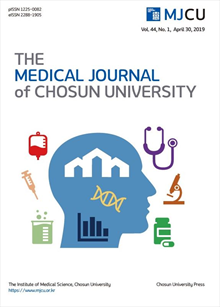간행물
The Medical Journal of Chosun University 조선대학교 의대논문집

- 발행기관 조선대학교 의학연구원
- 자료유형 학술지
- 간기 반년간
- ISSN 1225-0082 (Print)2288-1905 (Online)
- 수록기간 2013 ~ 2019
- 주제분류 의약학 > 의학일반 의약학 분류의 다른 간행물
- 십진분류KDC 510DDC 610
권호리스트/논문검색
Vol. 42 No. 2 (2017년 6월) 6건
1.
2017.06
서비스 종료(열람 제한)
The clinical importance of biologic markers remains elusive in gastric cancer. The aim of this study was to evaluate the prognostic value of p53, Ki-67, and COX-2 in gastric cancer. This retrospective study examined based on medical records of postoperative immunohistochemical test of 176 patients who demonstrated high expression of all three biological markers being tested (p53, Ki-67, and COX-2), among 357 gastric cancer patients who underwent surgical resection consecutively. This study demonstrates the correlation with biologic marker between clinical relationship and recurrence free survival (RFS). A positive correlation was observed between the expression of Ki-67 and p53, and a positive correlation was also observed between the expression of Ki-67 and COX-2 Expression of p53 did not correlate with any of the clinicopathological variables examined. Both Ki-67 and COX-2 expression significantly correlated with tumor depth, classified as early gastric cancer and advanced gastric cancer. The expression of COX-2 significantly correlated with tumor differentiation, with more tumors being of the undifferentiated type than of the differentiated type in the COX-2 positive group. A significant difference between p53 and RFS, also COX-2 expression and RFS was observed. This study showed that only p53 and COX-2 have significantly correlated with the RFS of gastric cancer.
2.
2017.06
서비스 종료(열람 제한)
This study was undertaken to evaluate the association between the appearance of hypodense hepatic nodules on dynamic CT images and acute alcoholic hepatitis in patients with alcoholic cirrhosis. Sixty-two patients (male:female=57:5, mean age=51.4±10.9 years) with alcoholic cirrhosis were included. Patients were divided into 3 groups; group A (nodules, n=23), group B (fatty liver < 40 Hounsfield unit (HU) without nodules, n=18), and group C (control, n=21). Liver nodules in Group A had characteristic low density during pre- and all post-contrast phases versus liver parenchyma and fewer or complete resolution of nodules on follow up CT after alcohol withdrawal. Densities (HU) of nodules and hepatic parenchyma, ascites scores, and laboratory values were analyzed. Mean densities of hepatic parenchyma in groups A and B were significantly lower than in the control group. Serum bilirubin, AST (aspartate transaminase), ALT (alanine transaminase), PT (prothrombin time), and ascites scores were significantly higher in group A than in the other two groups. As numbers of liver nodules increased nodules’ attenuation decreased. Mean serum AST and ALT were higher in patients with many nodules than in patients with few nodules. Hypodense hepatic nodules in alcoholic steatohepatitis in patients with alcoholic cirrhosis are probably benign nodules resulting from focal steatosis or hepatocellular necrosis rather than metastases.
3.
2017.06
서비스 종료(열람 제한)
Measures of radiographic pelvic and spinal parameters of sagittal balance analysis have become of considerable importance for reconstructive surgery of the spine, particularly in cases of degenerative spondylolisthesis. The authors conducted a retrospective study of clinical outcomes and a radiological review on 231 patients with one or two level degenerative spondylolisthesis. First, patients were classified using preoperative pelvic parameters and evaluations were conducted using mean values of pre- and postoperative spinopelvic parameters. Second, patients were divided into two study groups, that is, Group A (n=105; exhibited no improvement (increase or no change) in pelvic tilt postoperatively) and Group B (n=126; exhibited pelvic tilt improvement (decrease) postoperatively). Clinical outcomes in the two groups were compared using Visual Analogue Pain Scores (VAS) and Oswestry disability index (ODI). All preoperative pelvic parameters show restoration tendency after PLIF surgery for spondylolisthesis, and greater deviations of preoperative pelvic parameters from normality showed greater recovery postoperatively. VAS and ODI improvements at follow-up were poorer in group A than in group B.
4.
2017.06
서비스 종료(열람 제한)
Primary breast sarcomas are very uncommon. They represent less than 1% of all primary breast malignancies and less than 5 % of all sarcomas. We report a case of a patient with primary breast sarcoma who underwent left breast conserving surgery with sentinel lymph node biopsy.
5.
2017.06
서비스 종료(열람 제한)
Reversible cerebral vasoconstriction syndrome (RCVS) is a clinic-radiologic syndrome characterized by severe headache and reversible multifocal arterial constrictions that resolve within 3 months. RCVS can be either spontaneous or related to a trigger, such as vasoactive drugs. The authors present the case of a 53-year-old woman who presented with recurrent thunderclap headache. Initial computed tomography angiography demonstrated segmental vasoconstriction of bilateral anterior cerebral arteries. Fourteen days after, initial vasoconstriction was improved as determined by follow up CT angiography. Our patient had recurrent thunderclap headache for a considerable time (around 24 months). However, although she visited many hospitals, the headache was not controlled by any treatment. Fortunately, she did not have any neurological complication and her symptoms relieved after nimodipine treatment. Clinicians should be aware of possible RCVS when a patient has recurrent thunderclap headache for a protracted period.
6.
2017.06
서비스 종료(열람 제한)
Urachal cancer is extremely rare and accounts for fewer than 1% of malignant neoplasms of the bladder. Urachal remnants persist from the bladder dome to umbilicus after birth, and urachal carcinoma may arise from any of these segments. The standard treatment for urachal cancer is primarily wide excision with extended partial cystectomy of the urachal mass, urachal tract and umbilicus, and pelvic lymph node dissection. Nevertheless, prognosis is generally poor because early diagnosis is difficult and local invasions, distant metastasis, and recurrence frequently develop. The authors present a patient with recurred urachal adenocarcinoma, who was treated by partial cystectomy with lymph node dissection. One year after subsequent concurrent chemoradiotherapy, she achieved complete remission. A brief review of the literature on urachal adenocarcinoma is provided.

